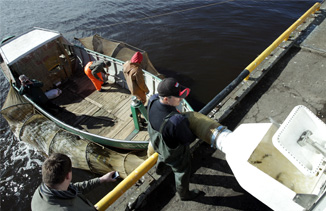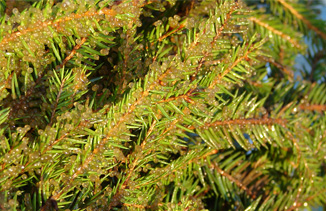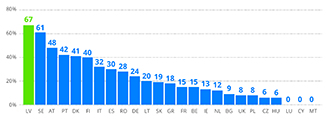
-
It is situated on Aiviekste River, the largest tributary of the Daugava River, in Kalsnava Parish, Madona Municipality, 14 km from the Daugava River mouth.

-
Aiviekste HPP was the first hydropower plant to start generating power in Latvia. From 1925 to 1938 it was the biggest in Latvia. The total installed capacity of the turbines was 1070 hp.
-
An inhabited locality of Aiviekste started to develop on the right bank after Aiviekste HPP was constructed.
-
Aiviekste HPP discontinued its operation in 1969, and in 1994 it was put back in service.
-
The total installed capacity of Aiviekste HPP is 0.8 MW. If the water inflow is sufficient, it can generate up to 3 GWh of power per year, which is equivalent to approximately 0.1% of total electricity generation of Latvenergo AS.
-
River bank erosion is a natural process – this is how the river creates its bed. Yet, the erosion of the Daugava River banks is also caused due to water level fluctuations generated by hydropower plants, as well as natural phenomena, such as ice drift, water currents, wind, precipitation, etc. Every year, Latvenergo AS allocates funds of more than EUR 1.2 million for reinforcement of the reservoir banks of the Daugava hydropower plants and operation of protective engineering structures of the reservoir of Riga HPP.
-
The total length of dams, dykes and onshore facilities in the cascade of Daugava hydropower plants is approximately 22 km.
-
During the summer, Latvenergo AS carries out restorative maintenance in the area of variable water levels of Daugava hydropower plants in order to ensure the safe operation of hydraulic structures. This work is conducted in accordance with the water level drawdown authorized by the Regional Environmental Board of the State Environmental Service.
-
The drop of the Daugava River within Latvia is about 100 m, of which 72 m are used for electricity generation. Plavinas, Kegums and Riga HPPs together make up the Daugava HPPs cascade, which is actually partly an artificial flooding system.
-
Prior to the period of spring floods, we can bring the water level down at hydropower plants by generating power, if necessary, because when the flood starts, a sudden release of an ice jam can produce large quantities of water in the reservoir, increasing by a meter in a few minutes. In case of necessity, the shutters of the hydropower plants can be raised quickly, ensuring the draining of the necessary amount of water through spillways.
-
To minimize the impact of HPP operations on natural regeneration of fish stocks in the Daugava River, Latvenergo AS has been implementing a programme of artificial replenishment of fish resources for many years.
The amount of contributions by Latvenergo AS to the fish replenishment programme is more than EUR 800 thousand per year.
-
Every year, at least 600 thousand Baltic salmon juveniles and brown trout smolt and juveniles, 400 thousand common bream, vimba, perch and pike juveniles and 5 million lamprey and pike larvae are released into the Daugava River basin.

-
To ensure the protection and replenishment of fish resources, Latvenergo AS, by engaging the employees of the Group and together with the association Mēs zivīm (We to Fish), organizes the placement of artificial spawning nests in the Daugava River every spring.

-
Daugava HPPs provide environmentally friendly generation of electricity, because they use a renewable resource – water.
-
Latvenergo Group’s hydropower plants on the Daugava River generate up to 90% of the electricity generated in Latvia, by using renewable resources and avoiding atmospheric emissions.
-
Latvenergo Group is one of the most environmentally friendly energygenerators in Europe. Well over half of our electricity is generated from renewable resources, thereby leaving a clean environment for future generations.
-
Independent studies carried out in various European institutions also confirm the status of Latvenergo AS as a green energy producer.
In accordance with EUROSTAT data for 2013, the amount of energy generated from renewable resources enables Latvia to rank first
among the European Union countries and the second among all countries in Europe, yielding the first place to Norway. 67% of the final
energy consumption in Latvia comes from renewable resources.

-
The HPPs built on the Daugava River help to prevent flooding downstream of the HPPs, including the flooding possibility in Riga. Riga Dome Cathedral still bears a mark showing how high the river used to rise: the spring waters reached this historic site several times. In 1709 and 1744, the water in the cathedral was at the level of human height.
Such incidents are not likely to occur in Riga again, as intense ice jamming happens upstream of Plavinas HPP.
-
Contrary to a frequent assumption that the construction of hydropower plants has increased the possibility of flooding in the populated areas near the Daugava River, measurements show that the constructed HPPs have actually improved the safety of people living downstream of Plavinas HPP at the Daugava River. Compared to the rise in the water level observed over the previous years, the areas flooded in the first half of the 20th century were much larger. Moreover, it used to be impossible to adjust the water level, whereas now this can be done to a certain extent.
-
During the spring floods, the water level in the Daugava River is affected by the amount of rainfall and snow in Belarus and Russia, as two thirds of the total river basin are located in the territories of those two countries.
In the springtime, it is essential that warm weather comes to Latvia first and only then to Belarus. In this case, it is possible to gradually bring down all the water, which has accumulated in the Daugava basin, by generating power. If the rapid melting of snow and ice first starts in Belarus, it can lead to ice jamming in the Daugava River and a sharp increase in the water level.
-
The excessively high water inflow is not beneficial for hydropower plants, because it causes the so-called peaks or excess water, which HPPs are unable to pass through hydropower units for generation of electricity. Instead, the water has to be poured through the shutters. In years of higher water inflow, the period of a lot of water typically ends more quickly. It is more advantageous for generation to have steady water inflow in the period of spring floods, because in that case the maximum amount of water can be used for electricity generation.
-
The period of spring floods in the Daugava River, when all three hydropower plants can generate electricity with a maximum capacity, varies each year depending on the weather, but on average it lasts 1-2 months a year.



